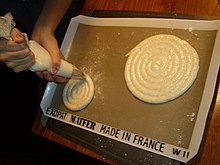 Eggnog mousse cake with almond dacquoise | |
| Type | Cake |
|---|---|
| Course | Dessert |
| Place of origin | France |
| Serving temperature | Chilled |
| Main ingredients | Meringue (almonds and hazelnuts), whipped cream or buttercream, biscuit |
| Variations | Marjolaine |
A dacquoise (French: [dakwɑz] ) is a dessert cake made with layers of almond and hazelnut meringue and whipped cream or buttercream. [1] It is usually served chilled and accompanied by fruit.
Contents
The term dacquoise can also refer to the nut meringue layer itself.
